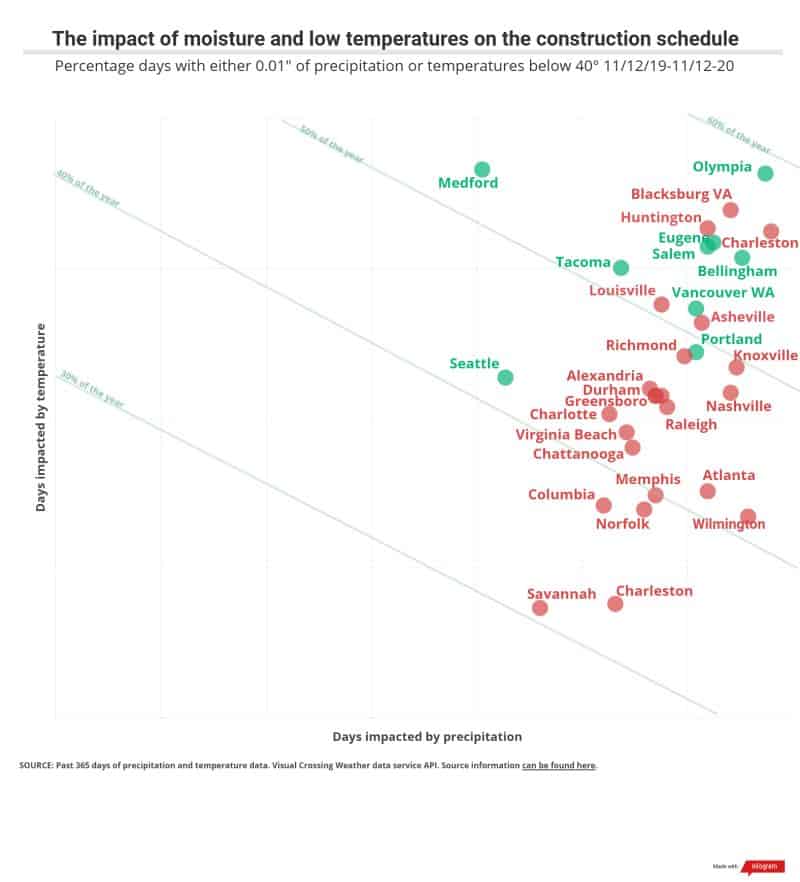A major challenge for builders is rainy weather, especially when scheduling the application of air and water barriers. Even if you aren’t building in Hawaii or Alaska, where rain falls more than 200 days a year and totals more than 200 inches a year, rain can impact project timelines. In the lower 48, western Washington and the north coast of Oregon are the wettest areas with more than 100 inches of rain each a year. The reality is that rainy days are increasing nationally.
The construction industry loses billions of dollars on delays and failures caused by bad weather. Storms damage buildings, sites turn into mud, and freezing temperatures put off concrete pours. It makes sense, therefore, to use seasonal forecasts to predict timelines, and choose products accordingly to minimize your down time during weather-related delays.

Regional weather—How many days do you have?
Fluid-applied flashing materials for air and water barriers offer many advantages over peel-and-stick, sheet goods or house wraps for building envelopes. However, not all fluid-applied products or even ones made with silyl-terminated polymer (STP) technology are equal.
For instance, there are some differences in the temperatures, and rainy or damp conditions in which these products can be installed and still live up to their performance expectations. Even though these differences may seem minor, they can turn into big delays on the job site depending on your region’s climate and unanticipated weather events. For instance, if you can’t apply the product when the temperature is below 40°F, or when your substrate is damp, you’ll end up in a waiting game for temperatures to rise and for the material to dry out.
Across the country, these two factors of moisture and temperature can wreak havoc on construction schedules (See How Weather Affects Your WRB Installation).
In the chart below, major cities in Georgia, South Carolina, North Carolina, Tennessee, Virginia and West Virginia are displayed as red dots, and major cities west of the Cascades in Oregon and Washington are displayed as green dots.
Here’s the breakdown of percentage of days affected by precipitation/percentage of days affected by temperature/ and total percentage of days affected on a typical job site in four locations:
- Richmond, VA: 30/27/53%
- Portland, OR: 30/ 27/52%
- Columbia, SC: 26/16/41%
- Seattle, WA: 21/26/43%

Exposure to UV is another important consideration in barrier product selection. Several fluid-applied products can be exposed to UV (before the exterior cladding goes up) for only six months. If you can’t complete the air/water barrier installation in 40-50% of the days in an average month in your region, the limitation needs to be taken into account when sequencing trades and creating your construction schedule.
Read the fine print!
Although traditional air barriers keep water out when fully cured, the introduction of moisture before the air barrier is fully cured is problematic. Using fluid-applied flashing is advantageous over peel-and-stick, yet not all fluid-applied products, or even ones made with silyl-terminated polymer (STP) technology, are equal.
Here is a common statement from acrylic emulsion air barrier literature stating that they cannot be installed in wet conditions or even if there is a chance of rain. If it does rain within the 16-hour window, the air barrier can literally wash right off the wall.

Be sure to read the details on a product’s data sheet and technical specs. Ignoring fine print can turn into huge construction delays depending on your region’s climate and unanticipated weather.
Why PROSOCO R-Guard?
PROSOCO’s R-Guard Cat 5 family of air and water barriers can eliminate many of these weather-related installation delays. That’s because the STP products in the R-Guard system (including Joint & Seam Filler, FastFlash, Cat 5 and AirDam) are immediately waterproof, can be applied to damp surfaces, and are actually moisture-cured. They also can be applied in temperatures below 40°F and can be exposed to weather and UV for up to 12 months before being covered with exterior sheathing.
R-Guard Joint and Seam Filler is designed to fill openings and create transitions where flexible reinforcement is required. FastFlash liquid flashing membrane is used in rough openings to fill joints and seams, counter-flash waterproofing and air barrier components, and to seal around penetrations. PROSOCO’s R-Guard Cat 5 goes over the field of the wall to produce a highly durable, seamless, elastomeric weatherproofing membrane and is proven to prevent water and air penetration even in the 155-mph winds of a Category 5 hurricane. AirDam is a sealant for windows and doors that prevents moist air from entering and should be used in rough openings treated with FastFlash.
So, if you’re waiting for ideal weather conditions for your residential or commercial build, and your weather forecast is dismal, R-Guard air and water barrier products can keep your project on track. There may be many reasons for work delays—but precipitation and cold temperatures don’t have to be among them.
![]()